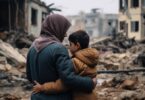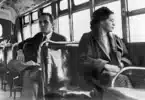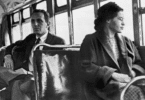In many societies, young people are looked down on. They’re viewed as powerless, entitled, or even lazy. They’re expected to obey authority without question. However, students have led many of history’s greatest protests. They recognize oppression and injustice and organize in mass, often putting their lives and futures at risk. Here are 11 examples of students protests that changed the world:
#1. The Fisk University protests
1925
Fisk University has a long history of student activism. In 1925, Fisk president Fayette McKenzie restricted many student activities, including discontinuing the school newspaper, cutting most extracurriculars, and putting restrictions on interactions between male and female students. McKenzie was also seeking endowments from foundations that didn’t want students to challenge Jim Crow laws. W.E.B. Du Bois, who had attended Fisk, gave a speech on campus criticizing McKenzie.
Students and alumni began demanding changes, which McKenzie initially agreed to enact, but then he backtracked. In March, after a peaceful protest, McKenzie called the police, who broke into the men’s dorm violently searching for the “agitators.” This act turned the tide in the students’ favor. More protests began, as well as a boycott of the school. In April, Fisk resigned.
#2. The White Rose
1942-1943
The White Rose was a peaceful resistance group in Nazi Germany. The group’s founders, who were medical students, watched SS troops murder Jewish civilians on the Eastern Front. Upon returning to Munich, the group joined with other students and began anonymously publishing leaflets opposing the Nazi regime they’d once supported. Siblings Hans and Sophie Scholl were central figures in the group. By 1943, The White Rose was painting graffiti on buildings around Munich with phrases like “Down with Hitler.”
The group was caught spreading leaflets and arrested. They went through a sham trial and were beheaded. On the day before her execution at 21 years old, Sophie wrote the word “Freiheit” on the back of her indictment. Freedom. Today in Germany and abroad, the White Rose resistance is highly respected and inspiring to young activists.
#3. The Greensboro sit-in
1960
Peaceful sit-ins at segregated lunch counters were some of the first protests during the Civil Rights movement in the United States. In 1960, four Black students from the North Carolina Agricultural and Technical College planned a sit-in at Woolworth’s. On February 1, they went inside and sat at the lunch counter. When denied service, they refused to leave. Police quickly arrived, but the students remained calm. A local white businessman, who was working with the students, alerted the media, who spread the protest’s message.
The protests grew so that by February 5th, there were 300 student protesters at Woolworth’s. The sit-in movement spread to other college towns and included segregated libraries, hotels, and other businesses. By the summer, many businesses and public facilities began integrating, including the Greensboro Woolworth’s.
#4. The Kent State University shooting
1970
Protests against the Vietnam War persisted through the 1960s, many of them led by students. When Richard Nixon was elected in 1968, he promised to end the war, but in 1970, the US invaded Cambodia. Protests began the next day, including at Kent State University. Over the next few days, tension built up between police and protesters. On May 4th, university officials tried to ban a scheduled protest, but around 3,000 people showed up anyway. They were greeted by 100 Ohio National Guardsmen armed with military rifles. When the crowd started shouting and throwing rocks, the Guardsman opened fire, killing four students and wounding nine. The most famous image of the carnage, a Pulitizer prize-winning photo by John Filo, shows a 14-year-old girl crouched over the body of one of the victims.
The Kent State campus shut down and a nationwide student strike with nearly 4 million participants took place. Anti-Vietnam War protests like the one at Kent State changed student activism forever, raising the stakes of protesting and cementing an anti-war sentiment in millions of Americans.
#5. The Tlatelolco massacre
1968
The 1960s was a tumultuous time all over the world, including in Mexico. The student protests began after riot police were sent to deal with a fight between high school students. When the police failed, the army arrived, killing a handful of students after blasting open a campus door. Students quickly organized, and over the next months, protests against oppression and violence took place. The government refused to meet the student’s demands, however, and on October 2, 1968, thousands gathered at the Three Cultures Square in the Tlatelolco housing complex. Soldiers showed up to arrest the student leaders, but when gunshots rang out, the soldiers began shooting.
Government sources claimed only four people were killed, but witness accounts describe hundreds of bodies. A formal investigation didn’t take place for decades and it’s still unclear how many died, but official documents suggest a special branch of the military posted snipers to provoke the troops. Today, October 2 is recognized as a National Day of Mourning and a symbol of resisting authoritarianism, with Mexicans saying “October 2, never forget.”
#6. The Soweto Uprising
1976
In South Africa, the apartheid system fueled violence and discrimination against Black South Africans from 1948-1991. Unequal education was a major part of apartheid. In 1953, the Bantu Education Act brought Black South African education under the national government’s control. The schools were not maintained well, and in 1961, only 10% of Black teachers had graduated high school. In June of 1976, between 3,000-10,000 students marched in protest of a specific educational directive and unequal education as a whole.
Armed police attacked the march, killing between 176-700 people and injuring about 1,000. Students continued to organize and anti-apartheid protests spread across the country, drawing international attention and condemnation of the apartheid regime. Groups around the world began pushing universities to drop their investments in corporations supportive of the South African government, setting the stage for the end of apartheid. Today, June 16th is National Youth Day in South Africa.
#7. The Velvet Revolution
1989
Since the end of WWII, the Czechoslovak government had been controlled by a Communist party that suppressed criticism. In 1989, nine days after the Berlin Wall fell, students gathered in Prague to recognize the 50th anniversary of a protestor’s death during a demonstration against Nazi occuptation. The protest transformed into an anti-government event with students chanting anti-Communist slogans. The police responded with violence, but protests grew and spread to other cities. On November 20, 500,000 protesters gathered in Wenceslas Square.
Eight days later, the Communist Party leadership resigned, making way for a new anti-communist government. Václav Havel, a poet, playwright, and major leader of the democratic movement, was elected president. The Czech and Slovak regions separated, and in 1993, Havel was elected as the first president of the Czech Republic. Because the students peacefully overthrew the government, those critical weeks of protests became known as the Velvet Revolution.
#8. Tiananmen Square
1989
In spring 1989, Chinese students were growing eager for political and economic reform. Despite relative prosperity, high inflation and corruption sullied the government’s reputation. Students began protesting for more individual freedoms and human rights. When one official supportive of democratic reform – who had been forced to resign – died, huge numbers of student protesters gathered. In Tiananmen Square, a demonstration grew to one million.
To disperse the crowds, the People’s Liberation Army arrived with tanks and tear gas. It’s unknown how many were killed or wounded, but thousands were arrested and some executed. The protesters were eventually cleared, though not before a photographer snapped a picture of a lone man squaring up to a row of tanks. The photo quickly became legendary and was censored within China. The man has never been identified, but his image lives on as a symbol of resistance.
#9. March for Our Lives
2018
On Valentine’s Day in 2018, a gunman killed 17 students at Marjory Stoneman Douglas High School in Parkland, Florida. Students from the school founded Never Again MSD and began organizing a rally called “March For Our Lives.” The march occurred on March 24 with hundreds of rallies across the US. Between 1-2 million people participated, making it one of the largest student-led protests since the Vietnam War.
Students called for increased gun regulations, including universal background checks, a ban on high-capacity and bump stock sales, and raising the federal age of gun ownership/possession to 21 years old. Students across the world organized rallies in solidarity. As America continues to reel from frequent mass shootings, students will remain a powerful force in the fight for change.
#10. The Global Climate Strikes
2019
In 2018, Greta Thunberg began protesting outside the Swedish parliament with a sign reading, “School strike for climate.” Her protest earned international attention and by 2019, global strikes were being organized. Known as the Global Climate Strikes, events were scheduled in over 163 countries on seven continents. It’s hard to pin down exact numbers, but millions participated in what was at the time the largest climate change protest. Youth-led climate protests continue to proliferate across the world. While Greta Thunberg is the most famous young climate change activist, many other students are pressing for action around the world. If major progress on climate change occurs, it will be young people driving it.
#11. Youth protests in Thailand
2020-2022
In 2019, Thailand moved from a military dictatorship to a semi-elected government, though it remains dominated by the military. Authoritarian tactics remain, leading to mass demonstrations in 2020. Students began organizing protests and rallies, drawing thousands of participants. They adopted a three-fingered salute that originates from The Hunger Games franchise. The movement didn’t have a clear leader, so many groups used social media to organize and call for democracy. Protests became violent as police escalated with tear gas and rubber bullets.
Due to the COVID-19 pandemic, police harassment, prosecutions of protesters, and internal conflict, the youth-led movement has mostly left the streets. We will see if protests will gain more steam in 2023 when Thailand has its general election.
You may also like: Learn more about protests, uprisings, revolutions.












